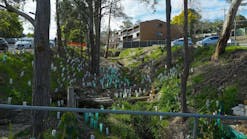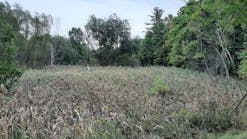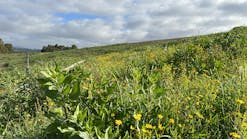About the author: Jon Moody is vice president of Thirsty Duck Inc. Moody can be reached at [email protected] or 727.376.2400.
Low-impact development (LID) is one of the hottest topics of the day and its environmental benefits are highly touted. Its techniques are being implemented more frequently, and many regulatory stormwater programs across the country are adopting rules and regulations that favor its use as the primary method of stormwater management.
When examining techniques or tools like rain gardens, bioretention areas, disconnecting impervious areas, green roofs, pervious pavements and more, one can ask the question: Are these practices truly effective in addressing flood control? One answer is that it depends how the designer and the regulatory program assume it works. After all, even though the current focus of the stormwater and erosion control industry is water quality, a major purpose of stormwater management practice and regulation is flood protection, which is why designs for 25-year and 100-year events are analyzed.
All LID practices provide some level of water quality and flood protection benefit. However, the extent to which a LID design element provides a benefit depends on the assumptions made about its performance and the method by which it is evaluated. Most stormwater regulatory programs require event-based analysis using the Soil Conservation Service Curve Number Method (TR-55), and the effectiveness of the method is highly dependent on the selection of an appropriate curve number (CN). In reviewing the regulations and basis of design review for many jurisdictions, the assumptions and application of the CN method vary widely, especially when it comes to LID.
LID and Green Roofs
For example, an extensive green roof contains a 4- to 6-in.-thick growing media underlain by drainage media, which in turn is underlain by an impermeable membrane to prevent seepage into the building’s interior. The developed land uses and cover types described in Table 2-2a of TR-55 do not include green roofs, and the agricultural covers and treatments listed in Tables 2-2b and 2c do not include an under-drained growing media. A judgment must be made as to the amount of runoff produced by a green roof. High CN values (such as 98 for pavement) cause most of the rainfall to appear as runoff, with minimal losses. Lower values correspond to an increased ability of the soil to retain rainfall, and will produce much less runoff. Should the roof be modeled with a CN of 98 or should it be modeled as open space with good cover? If it is open space with good cover, what soil type should the CN be based on? Would it be more accurate to back-calculate CN based on the porosity of the growing media?
Consider a green roof area of 10,000 sq ft and a rainfall depth of 6 in. If the design engineer rationalizes that the roof should be modeled as open space with good cover, and the growing media is most similar to a Hydrologic Soil Group (HSG) B soil because of its rapid infiltration capacity, then the CN is 61. The direct runoff produced by the roof is 2.01 in. The total runoff volume is 1,675 cu ft and the volume retained is 3,325 cu ft. If he later decides the growing media function more like an HSG D soil due to the presence of the impervious membrane, then the CN is 80. The direct runoff produced by the roof is 3.78 in. The total runoff volume is 3,150 cu ft and 1,850 cu ft is retained.
If the regulatory agency argues that the roof should be modeled as CN=98 since membrane under the growing media is impervious, the amount of direct runoff produced by the roof is 5.76 in. The total volume of runoff is 4,800 cu ft and the volume retained is 200 cu ft.
After much discussion, the engineer and regulatory agency agree that the green roof should be evaluated based on available storage volume in the growing media, and it is assumed the media have 30% void space, is 4 in. thick and the amount of runoff volume is 4,000 cu ft. The volume retained is 1,000 cu ft and the equivalent CN is 90.
So which is it? What is the right answer? It all depends on who you ask.
Variety of Standards
The Maryland Department of Environment says it bases the CN value for a green roof on the storage capacity of the media. The CN is estimated based on the assumption that the growing media can retain 0.2 in. per inch of media depth. The CN value ranges between 60 and 90 depending on the depth of the rainfall event to be analyzed.
According to the The Center for Neighborhood Technology, a sustainability think tank located in the Midwest, the CN value for a green roof is 75. No justification of the number is discussed in the methodology document for its Green Values Stormwater Calculator.
In Fairfax County, Va., the CN value used for an extensive green roof is 70 and a value of 65 is used for intensive green roofs. Intensive green roofs have a media depth greater than 6 in.
A study conducted between 2003 and 2004 by the University of Georgia experimentally determined the CN for a green roof to be 86. The data were published in the Journal of the American Water Resources Assn. in 2006.
In Florida and New Jersey, there is no published or accepted standard. A variety of design standards for LID techniques have been established by the New Jersey Department of Environmental Protection (NJDEP) and are published in the NJDEP Stormwater BMP [Best Management Practices] Manual; however, Chapter 9.8 is reserved for rooftop vegetated cover and is currently blank.
The same goes for many other LID techniques. There are many published studies demonstrating the potential runoff and peak flow rate reduction benefits of LID practices; however, very few have arrived at conclusions that are compatible for use with the method prescribed by TR-55. If LID is to be implemented as an effective runoff reduction technique, objective and reliable data need to be developed for the design method most commonly used by engineers and regulators.
Download: Here







